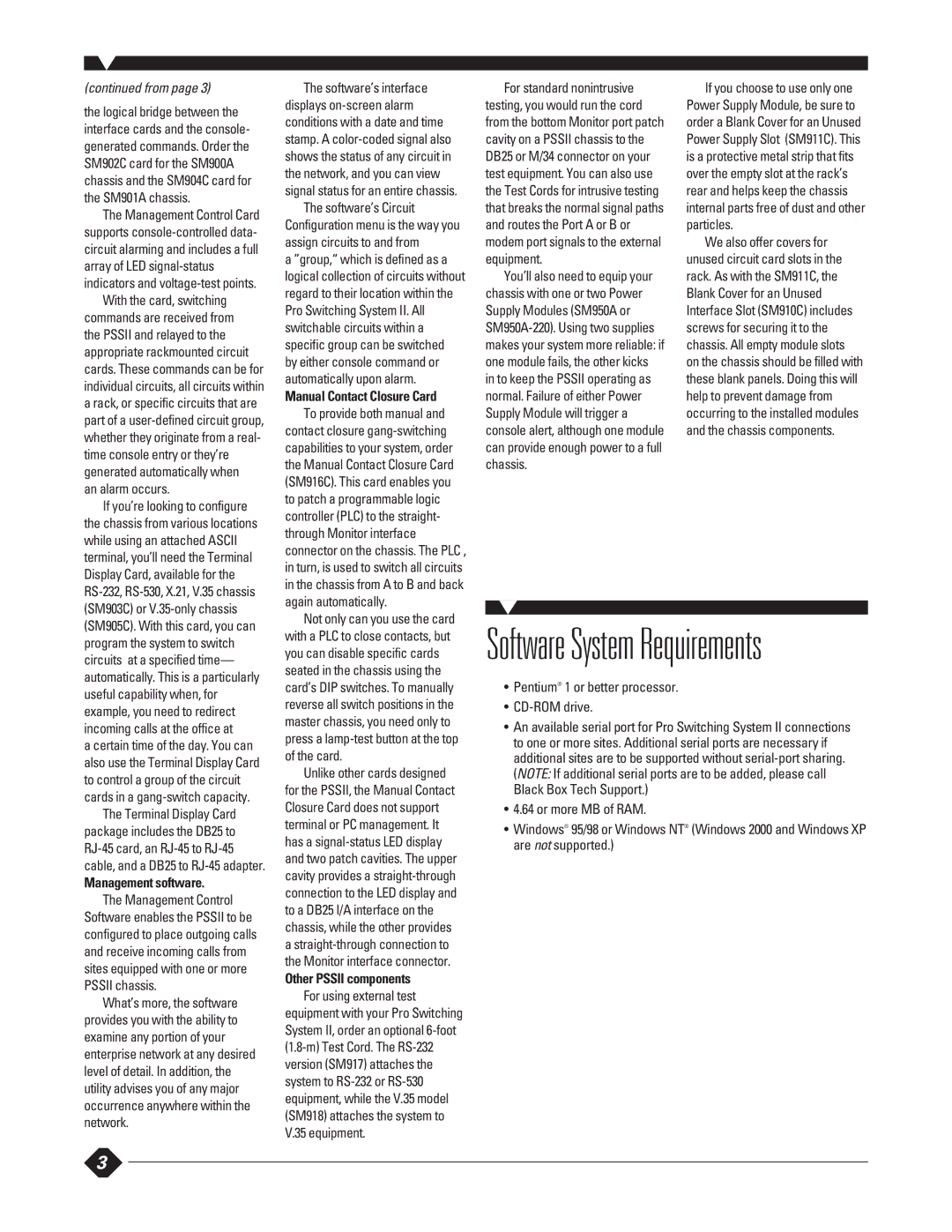(continued from page 3)
the logical bridge between the interface cards and the console- generated commands. Order the SM902C card for the SM900A chassis and the SM904C card for the SM901A chassis.
The Management Control Card supports console-controlled data- circuit alarming and includes a full array of LED signal-status indicators and voltage-test points.
With the card, switching commands are received from the PSSII and relayed to the appropriate rackmounted circuit cards. These commands can be for individual circuits, all circuits within a rack, or specific circuits that are part of a user-defined circuit group, whether they originate from a real- time console entry or they’re generated automatically when
an alarm occurs.
If you’re looking to configure the chassis from various locations while using an attached ASCII terminal, you’ll need the Terminal Display Card, available for the RS-232, RS-530, X.21, V.35 chassis (SM903C) or V.35-only chassis
The software’s interface displays on-screen alarm conditions with a date and time stamp. A color-coded signal also shows the status of any circuit in the network, and you can view signal status for an entire chassis.
The software’s Circuit Configuration menu is the way you assign circuits to and from
a ”group,“ which is defined as a logical collection of circuits without regard to their location within the Pro Switching System II. All switchable circuits within a specific group can be switched by either console command or automatically upon alarm.
Manual Contact Closure Card
To provide both manual and contact closure gang-switching capabilities to your system, order the Manual Contact Closure Card (SM916C). This card enables you to patch a programmable logic controller (PLC) to the straight- through Monitor interface connector on the chassis. The PLC , in turn, is used to switch all circuits in the chassis from A to B and back again automatically.
For standard nonintrusive testing, you would run the cord from the bottom Monitor port patch cavity on a PSSII chassis to the DB25 or M/34 connector on your test equipment. You can also use the Test Cords for intrusive testing that breaks the normal signal paths and routes the Port A or B or modem port signals to the external equipment.
You’ll also need to equip your chassis with one or two Power Supply Modules (SM950A or SM950A-220). Using two supplies makes your system more reliable: if one module fails, the other kicks in to keep the PSSII operating as normal. Failure of either Power Supply Module will trigger a console alert, although one module can provide enough power to a full chassis.
If you choose to use only one Power Supply Module, be sure to order a Blank Cover for an Unused Power Supply Slot (SM911C). This is a protective metal strip that fits over the empty slot at the rack’s rear and helps keep the chassis internal parts free of dust and other particles.
We also offer covers for unused circuit card slots in the rack. As with the SM911C, the Blank Cover for an Unused Interface Slot (SM910C) includes screws for securing it to the chassis. All empty module slots on the chassis should be filled with these blank panels. Doing this will help to prevent damage from occurring to the installed modules and the chassis components.
(SM905C). With this card, you can program the system to switch circuits at a specified time— automatically. This is a particularly useful capability when, for example, you need to redirect incoming calls at the office at
a certain time of the day. You can also use the Terminal Display Card to control a group of the circuit cards in a gang-switch capacity.
The Terminal Display Card package includes the DB25 to RJ-45 card, an RJ-45 to RJ-45 cable, and a DB25 to RJ-45 adapter.
Management software.
The Management Control
Software enables the PSSII to be configured to place outgoing calls and receive incoming calls from sites equipped with one or more PSSII chassis.
What’s more, the software provides you with the ability to examine any portion of your enterprise network at any desired level of detail. In addition, the utility advises you of any major occurrence anywhere within the network.
Not only can you use the card with a PLC to close contacts, but you can disable specific cards seated in the chassis using the card’s DIP switches. To manually reverse all switch positions in the master chassis, you need only to press a lamp-test button at the top of the card.
Unlike other cards designed for the PSSII, the Manual Contact Closure Card does not support terminal or PC management. It has a signal-status LED display and two patch cavities. The upper cavity provides a straight-through connection to the LED display and to a DB25 I/A interface on the chassis, while the other provides a straight-through connection to the Monitor interface connector.
Other PSSII components
For using external test equipment with your Pro Switching System II, order an optional 6-foot (1.8-m) Test Cord. The RS-232 version (SM917) attaches the system to RS-232 or RS-530 equipment, while the V.35 model (SM918) attaches the system to V.35 equipment.
Software System Requirements
•Pentium® 1 or better processor.
•CD-ROM drive.
•An available serial port for Pro Switching System II connections to one or more sites. Additional serial ports are necessary if additional sites are to be supported without serial-port sharing. (NOTE: If additional serial ports are to be added, please call Black Box Tech Support.)
•4.64 or more MB of RAM.
•Windows® 95/98 or Windows NT® (Windows 2000 and Windows XP are not supported.)

